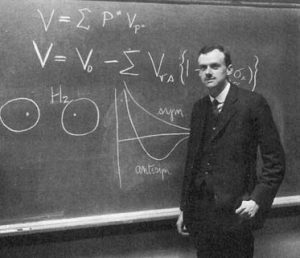
I recently published a post on the beauty of mathematics, and the importance that aesthetic considerations have had in its development.
It is perhaps surprising that in a science like physics, which is closer to the worldly affairs than mathematics, we can also find aesthetic arguments. These arguments have become more intense as physics has become more and more mathematised, to the point that, without exaggeration, we can say that they are a clear mathematical contamination of physics. To cite just a few examples, Paul Dirac (1902-1984), one of the giants of quantum mechanics, Nobel laureate in physics in 1933, wrote: “Every physical law must have mathematical beauty”, and also: “It is more important to achieve elegance in the equations themselves than to make them agree with the experiments. If there is not complete agreement between the results of one’s own work and the experiments, one should not be discouraged, because the discrepancy may well be due to secondary aspects which are not adequately taken into account and which will be solved with the further development of the theory. This is how quantum mechanics was discovered”.
 In the latter he agreed with Albert Einstein. Einstein went from being a disbeliever in mathematics, in its simplicity and beauty – “Beauty, gentlemen, we will leave it to shoemakers and tailors! The object of our research must always be the truth”, he was heard to say at the beginning of his career as a professor, to trust in mathematics as an inspiration and guide to scientific enquiry: “I am convinced that we can discover, by means of pure mathematical constructions, the concepts and laws which link them mutually and which provide us with the key to the understanding of natural phenomena. Experience may suggest the appropriate mathematical concepts, but it will certainly be impossible to deduce them from experience. Of course, experience remains the only criterion for the physical usefulness of a mathematical construction. But the creative principle lies in mathematics,” he said, and also: “I believe that nature is the fulfilment of the simplest conceivable mathematical ideas”. For Einstein, the limit to mathematical creativity was determined by the confrontation of physical theory with experimental fact: “All knowledge of reality starts from experience and ends in experience”; although at times he placed more value on consistency and simplicity: “I do not consider the greatest significance of the theory of general relativity to be some tiny observable effects, but the great simplicity of its foundations and its consistency”. Einstein ended up defending that the laws of physics – as if we were talking about metaphors – were a free invention of the human spirit, guided by reasons of aesthetics and mathematical simplicity, which had to be verified by observation; he expressed it on several occasions, as in this quote taken from his book The Evolution of Physics – written with his collaborator Leopold Infeld and published in 1938: “Science is not simply a collection of laws, a catalogue of unrelated facts. Science is the creation of the human mind, with ideas and concepts imagined in freedom”. In the last quote, Einstein intones for physics Cantor’s battle cry: “The essence of mathematics is freedom”.
In the latter he agreed with Albert Einstein. Einstein went from being a disbeliever in mathematics, in its simplicity and beauty – “Beauty, gentlemen, we will leave it to shoemakers and tailors! The object of our research must always be the truth”, he was heard to say at the beginning of his career as a professor, to trust in mathematics as an inspiration and guide to scientific enquiry: “I am convinced that we can discover, by means of pure mathematical constructions, the concepts and laws which link them mutually and which provide us with the key to the understanding of natural phenomena. Experience may suggest the appropriate mathematical concepts, but it will certainly be impossible to deduce them from experience. Of course, experience remains the only criterion for the physical usefulness of a mathematical construction. But the creative principle lies in mathematics,” he said, and also: “I believe that nature is the fulfilment of the simplest conceivable mathematical ideas”. For Einstein, the limit to mathematical creativity was determined by the confrontation of physical theory with experimental fact: “All knowledge of reality starts from experience and ends in experience”; although at times he placed more value on consistency and simplicity: “I do not consider the greatest significance of the theory of general relativity to be some tiny observable effects, but the great simplicity of its foundations and its consistency”. Einstein ended up defending that the laws of physics – as if we were talking about metaphors – were a free invention of the human spirit, guided by reasons of aesthetics and mathematical simplicity, which had to be verified by observation; he expressed it on several occasions, as in this quote taken from his book The Evolution of Physics – written with his collaborator Leopold Infeld and published in 1938: “Science is not simply a collection of laws, a catalogue of unrelated facts. Science is the creation of the human mind, with ideas and concepts imagined in freedom”. In the last quote, Einstein intones for physics Cantor’s battle cry: “The essence of mathematics is freedom”.
“Nature seems to take advantage of simple mathematical representations of the laws of symmetry,” wrote another Nobel laureate in Physics, C.N. Yang. When one stands back and contemplates the elegance and beautiful perfection of the mathematical reasoning involved, and contrasts it with its complex and far-reaching physical consequences, one never fails to develop a deep sense of respect for the laws of symmetry”. And as a final example, let us cite one of the books by Frank Wilczek, winner of the 2004 Nobel Prize in physics, whose title, The World as a Work of Art, is a statement of intent. In this book, Wilczek magnificently explains the fundamental importance that the sense of aesthetics, of beauty, has had in the development of physics – of how we have been unravelling the secrets of nature. Wilczek synthesises this artistic stamp of nature in two concepts: “symmetry – love of harmony, balance and proportion; and economy – satisfaction in producing abundant effects from very limited means”. And, to a large extent, this ideal of beauty has been inherited by physics from mathematics.
And this is where the question of the irrational efficacy of mathematics arises again with force. It has been dealt with in several posts on this blog: see The emotional and the rational, the abstract and the useful or Einstein, Wigner and the mystery of Mathematics. Aesthetic questions, including mathematics, belong to human subjectivity and should be a poor guide to explain nature; and yet everything seems to indicate the opposite: “The mathematician plays a game whose rules he has invented himself – I quote Dirac again – while the physicist plays a game in which the rules are determined by nature; however, as time goes by, it becomes more and more evident that the rules that the mathematician has found interesting are the same ones that nature has chosen”.
References
A.J. Durán, Crónicas matemáticas, Crítica, Barcelona, 2018

Leave a Reply